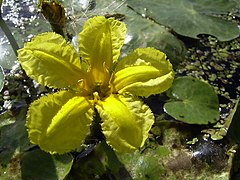Nymphoides peltatum
| Nymphoides peltatum subsp. var. | Fringed Water-lily, Yellow Floating-heart, Water Fringe | |||||||||||||||||||||||||||||||||||||||||||||||||||||||
|---|---|---|---|---|---|---|---|---|---|---|---|---|---|---|---|---|---|---|---|---|---|---|---|---|---|---|---|---|---|---|---|---|---|---|---|---|---|---|---|---|---|---|---|---|---|---|---|---|---|---|---|---|---|---|---|---|

|
|
| ||||||||||||||||||||||||||||||||||||||||||||||||||||||
| ||||||||||||||||||||||||||||||||||||||||||||||||||||||||
Nymphoides peltata (syn. Villarsia nymphaeoides, Fringed Water-lily, Yellow Floating-heart, Water Fringe) is an aquatic plant of the family Menyanthaceae native to Eurasia. It has cordate floating leaves that support a lax inflorescence of yellow flowers with fringed petal margins. The fruit is a capsule bearing many flattened seeds with stiff marginal hairs.
The plants are commonly sold for use in ornamental water gardens. Outside their native range, however, they can escape cultivation and become nuisance noxious weeds.
Flowers of N. peltata are heterostylous and weakly self-incompatible.
| Standard Cyclopedia of Horticulture |
|---|
|
Nymphoides peltatum, Brit. & Rend. (N. nymphaeoides, Brit. Limnanthemum nymphaeoides, Hoffm. & Link. Menyanthes nymphaeoides, Linn.). Plant stout and branching: Lvs. 2-4 in. broad: fls. 1 in. across or more; segms. obcordate, short-fringed. May-July. Eu., Asia; naturalized in District of Columbia.—Simulates Limnocharis Humboldtii in habit.
|
Cultivation
Propagation
Pests and diseases
Varieties
Gallery
References
- Standard Cyclopedia of Horticulture, by L. H. Bailey, MacMillan Co., 1963
External links
- w:Nymphoides peltatum. Some of the material on this page may be from Wikipedia, under the Creative Commons license.
- Nymphoides peltatum QR Code (Size 50, 100, 200, 500)
